How Are Compostable Plastic Bags Made?
Compostable plastic bags offer a sustainable alternative to conventional plastics, designed to return to the earth under the right conditions. But how exactly are they manufactured? This process involves transforming specific bio-based polymers through several key stages, including compounding, extrusion, and conversion. Let’s dive into the step-by-step journey from plant-based resources to the finished compostable bag.
1. Granulation
The manufacturing journey begins with preparing the compostable raw materials. This initial stage transforms them into uniform pellets suitable for making the film.
- Blending Compostable Resins: First, various compostable polymers – such as PLA, PBAT, and starch-based polymers – are carefully mixed together with additives. This blend, or ‘compound’, is precisely formulated to achieve the desired bag properties, like strength, flexibility, and suitability for printing, while ensuring it meets strict compostability standards (e.g., ASTM D6400, EN 13432). The exact recipe depends on the bag’s final application.
- Granulation: The blended compound is then fed into a granulator or pelletizer. Typically, a twin-screw extruder is used here because it ensures thorough mixing while melting the polymer blend. The molten plastic is pushed through a die and cut into small, consistent pellets. Using pellets ensures the material feeds evenly and melts uniformly during the next stage.
- Drying: Depending on the formulation, especially if it includes moisture-sensitive ingredients like starch, the pellets may need to be dried thoroughly before film blowing. Excess moisture can negatively impact the quality of the final film.
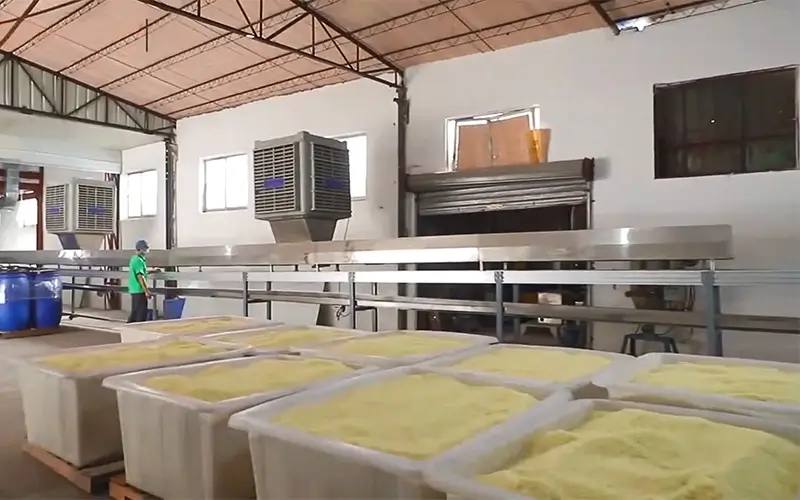
2. Film Blowing
This is the core process where the plastic pellets are transformed into a thin, continuous film – the basis of the bags.
- Melting and Extrusion: The dried pellets are fed into a film blowing machine’s extruder. Here, they are melted and forced through a circular die, emerging as a continuous tube of molten plastic.
- Inflation and Shaping: Compressed air is blown into the center of the molten tube, inflating it like a balloon. This stretching process determines the film’s final width and thickness. An air ring positioned around the outside of the die blows cool air onto the bubble, helping to solidify the plastic evenly and stabilize its shape as it rises.
- Cooling and Flattening: As the inflated bubble travels upwards, it continues to cool and solidify. It is then gently guided through a collapsing frame that flattens the tube.
- Winding: Finally, the flattened film tube is wound onto large rolls, ready for printing or direct conversion into bags.
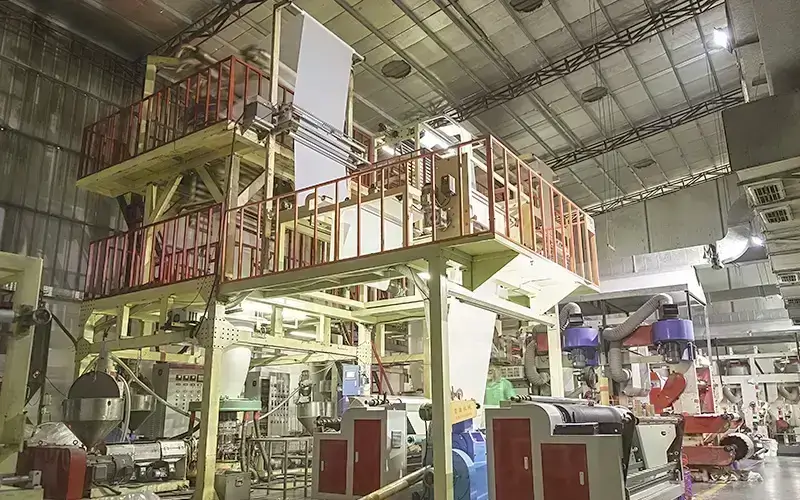
3.Printing
If the bags require branding, instructions, or designs, the film proceeds to the printing stage.
- Flexographic Printing: A common method used is flexographic printing, which employs flexible plates to transfer ink onto the film’s surface. This technique allows for high-quality, detailed, and multi-color printing.
- Eco-Friendly Inks: To maintain the product’s environmental credentials, water-based or other compostable-compatible inks are typically used. These are designed to break down along with the bag material.
- Process Integration: Printing can be done ‘inline’ (as a continuous step immediately following film blowing) or ‘offline’ (where the rolls of film are moved to a separate printing press), offering flexibility in the production workflow.
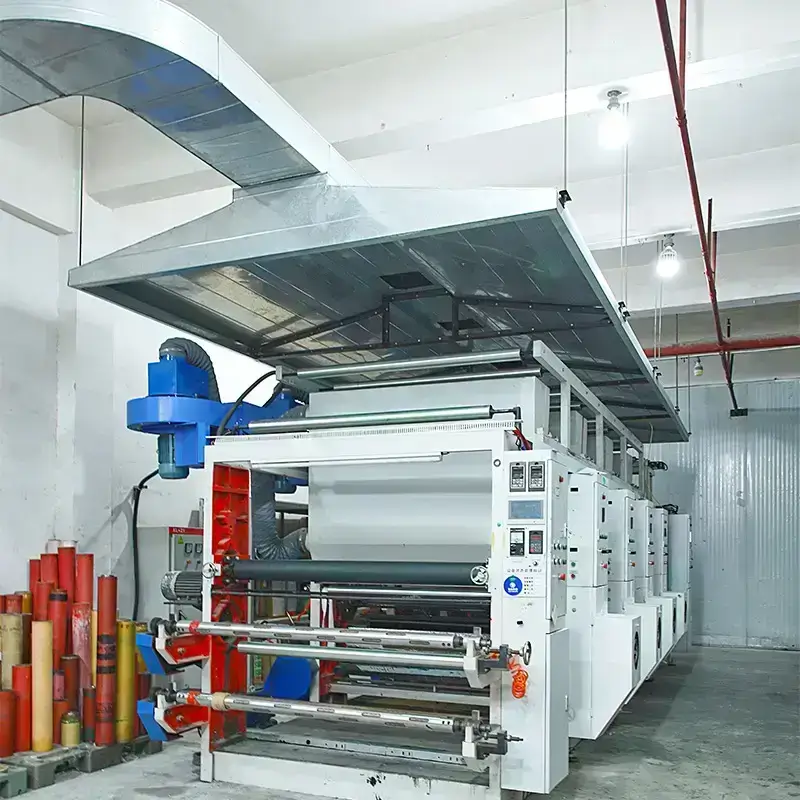
4. Bag Making
In this stage, the rolls of film (either plain or printed) are converted into individual bags.
Automated Conversion: Specialized bag-making machines automate several processes:
- Cutting: The film is precisely cut to the required length for each bag.
- Sealing: Heat or ultrasonic sealing creates strong seams at the bottom and sides. Temperature, pressure, and dwell time are carefully controlled to ensure a robust seal without damaging the film’s compostability.
- Folding & Gusseting (Optional): The machine might fold the top edge for reinforcement or create gussets (side folds) to give the bag more volume.
- Handle Punching (Optional): For styles like T-shirt bags, handles are punched out.
- Perforating (Optional): Perforations might be added, especially for bags supplied on a roll, allowing for easy separation.
- Stacking: Finished bags are automatically counted and stacked, ready for packaging.
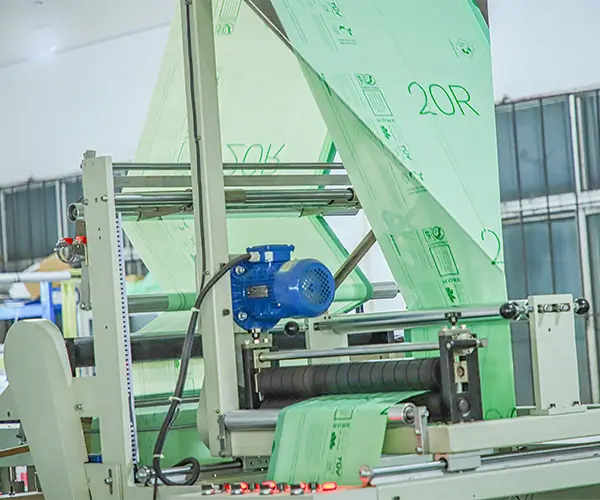
Types of Bags: Different machines are configured to produce various types of compostable bags, such as flat bags, side-gusseted bags, T-shirt bags, and drawstring bags.
5. Packaging
Bundling and Wrapping: Finished bags are typically counted automatically, bundled, and then wrapped in protective outer packaging. This packaging might be recycled paper, cardboard boxes, or even a larger compostable bag, ensuring the product is protected during shipping and handling.
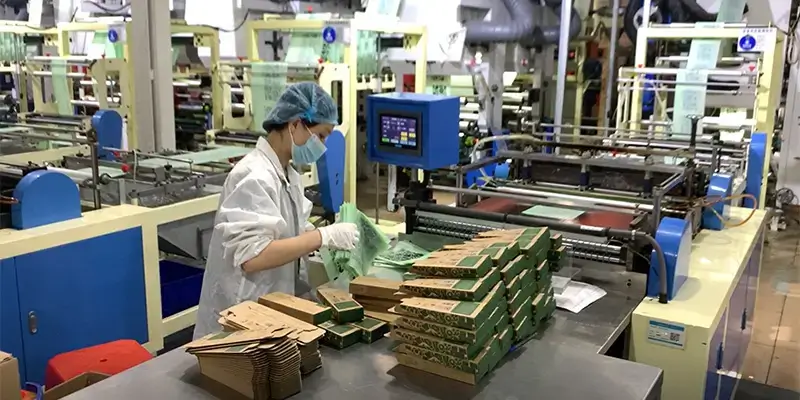
Important Considerations in Compostable Bag Manufacturing
- Certified Materials: Using only certified compostable resins sourced from reputable suppliers is crucial for legitimacy and performance.
- Strict Quality Control: Implementing rigorous quality checks throughout the process (e.g., regular inspections of material properties, seal strength, dimensions, and print quality) is essential to meet standards and customer expectations.
- Preventing Contamination: Maintaining dedicated equipment and strict cleaning protocols is vital to prevent contamination from conventional, non-compostable plastics, which could compromise the final product’s compostability.
- Certification Compliance: Ensuring the entire manufacturing process aligns with the requirements of relevant compostability certifications (e.g., BPI, TUV Austria HOME/INDUSTRIAL Compost, Seedling logo based on EN 13432) is key for market acceptance and environmental integrity.
Elevate Your Packaging Bag Production
As a specialist in equipment improvement, we provide the advanced machinery and expert guidance you need. Achieve smoother production runs, consistently high-quality bags, and meet industry standards.
Ready to improve efficiency and quality?